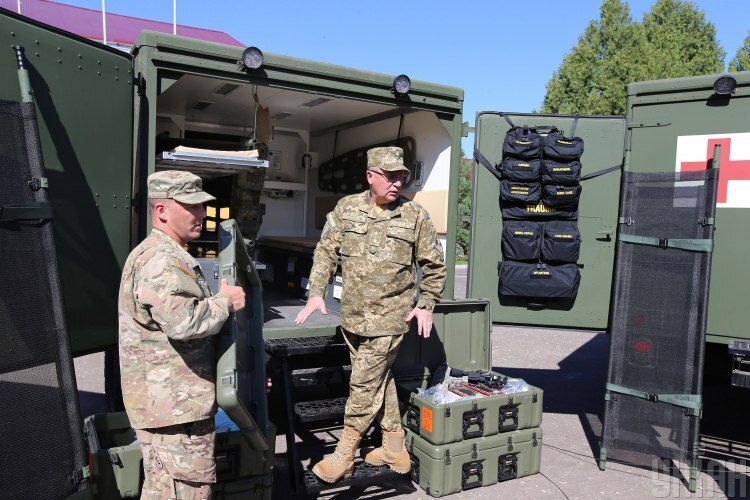"Incredibly cost-effective investment": Billions of US dollars invested in Ukraine's defence capability pay off many times for the United States itself
Experts have explained to Republican Congressmen why supporting the Ukrainian army is primarily beneficial for the United States
A group of Republicans, who won a majority of seats in the US Congress, staged a démarche against the intention of US President Joe Biden's administration to send another $37.7 billion to Kyiv. The CSIS and CEPA think tanks, which oppose them, call assistance to Ukraine an incredibly cost-effective investment for the United States.
The debate flared up after the White House requested an additional $37.7 billion for Ukraine from Congress on November 15, 2022, including $21.7 billion to strengthen defence capabilities and $14.5 billion to feed Ukraine's budget directly.
After these tranches are approvaed, the total amount of American assistance to our country will exceed $90 billion. Earlier in March, in response to the invasion of the russian army, the US Congress approved the transfer of $13 billion in emergency support to Kyiv and in May – another $40 billion.
Why did some Republicans decide to oppose the aid to Ukraine?
"With the money we have sent to Ukraine, we could have already secured our border by now, but we are not doing that," Marjorie Taylor Greene said, referring to the problems with the flow of illegal migrants from Mexico. "We are ignoring the dangers happening at our border and the national security crisis that is happening in our country while we are completely protecting another country's border and also waging a proxy war with russia."
Greene has promised to reintroduce her bill to audit funds for Ukraine in early 2023 when the new Congress takes office, in which Republicans have gained a majority. In May, 57 Republicans, including Marjorie Taylor Greene, voted against the $40 billion package of aid to Ukraine in the US Congress. She believes there will be more such votes.
If Congress votes this down, guess what the message will be to the American people? It will be, 'you don't get to find out what's happening with your money.' And I think that is a very bad message to tell the American people when it comes to the security of our border, the protection and safety of American citizens, especially when being compared to a foreign country." Marjorie Taylor Greene thinks.
Public opinion polls show growing dissatisfaction with the funding of Ukraine in the United States. In the spring, the vast majority of Republicans in the US Congress were unanimous with Democrats in condemning the russian invasion. Moreover, many Republicans criticized the Biden administration for not doing enough to help Kyiv. However, the durable war has changed sentiment: now 30% of all Americans and 48% of all Republicans say the US is doing too much for Ukraine, compared with 6% in March.
In the coming months, if the U.S. continues to sink into recession, the share of dissatisfied people may grow. It poses a threat of blocking Ukraine funding bills in the US Congress under the "Hastert Rule": if the majority within the majority party does not support a proposal, it is not brought to the floor.
How does Western aid change the "pattern of war"?

German Kiel Institute for the World Economy counted $92 billion of investments in Ukraine in January-October 2022. Over nine months, Kyiv received $37 billion in financial support from foreign countries, as well as $15 billion in humanitarian and $40 billion in military aid. The White House was the main source of these funds. Ukraine received 44% of budget support, 66% of humanitarian and 71% of military aid from the United States.
Read also: To restore everything: what you should know about the “Marshall Plan” for Ukraine
This support, which was coming along with anti-russian sanctions and diplomatic pressure, changed the balance of power. If at the beginning of the invasion on February 24, 2022, russia looked like Goliath attacking the poorest country in Europe, a completely different picture is emerging now. And on it, Goliath in shining armour is the United States.
The American Centre for Strategic and International Studies (CSIS) has recently issued a publication aimed to convince "few political figures like Marjorie Taylor Greene" who oppose funding for Ukraine.
"Much of this rising U.S. opposition to continuing aid to Ukraine does, however, come from only considering its cost and ignoring the strategic benefits it provides to the U.S. We have already obtained major strategic benefits from aiding the Ukraine, and that such aid it is one of the best investments the U.S. can make in competing with Putin’s Russia and in advancing its own security," writes Anthony H. Cordesman, military expert, who holds the Arleigh A. Burke Chair in Strategy at CSIS.
russia started the war with a significant military and financial advantage over Ukraine. russia's GDP in 2021 was $1.775 trillion – nine times more than Ukraine's $201 billion. According to the International Institute for Strategic Studies (IISS), russia also spent $62.2 billion on defence in 2021. It is 14 times more than the $4.35 billion spent by Ukraine.
However, in 2022, the US and allies poured more billions into Ukraine than russia was able to put into its military budget. Washington's predominant assistance means that russia is involved in a struggle with the United States, which has a GDP of $22.966 billion and a military budget of $811 billion, 13 times higher than its own.
"Focusing on the price tag of aid instead of the value of what it buys, ignores the fact that the war in Ukraine has become the equivalent of a proxy war with Russia, and a war that can be fought without any U.S. military casualties, that unites most of the world’s democracies behind a common cause, that deeply punishes Russia for its act of aggression and strengthens every aspect of deterrence," Anthony Cordesman writes.
According to him, the opponents of the US financial and military assistance to Ukraine do not take into account the fact that russia is much poorer than the United States and its allies. "They ignore the fact that russia is already paying far more of its Gross National Product and economy to fight the war in the Ukraine than the U.S. and its partners, and that russia has suffered massive losses of weapons, war reserves, and military personnel. U.S. aid has so far enabled Ukraine to do immense damage to russia’s overall capability to threaten Europe and to fight any future conflict. They ignore the practical benefits of the message that sending such aid to Ukraine has sent to our strategic partners and allies about American capability and resolve,” the CSIS official said.
What does the United States get in return?

The Washington-based Centre for European Policy Analysis (CEPA) has also refuted Republican arguments that downplay the risks posed by russia and call for spending money within the US.
"The cost-benefit analysis of US support for Ukraine is incontrovertible. It’s producing wins at almost every level," concludes Timothy Ash, British economist and Ukraine expert, in a publication for CEPA. “It is an incredibly cost-effective investment.”
According to him, the Ukrainian armed forces have already killed or wounded upwards of 100,000 Russian troops, half its original fighting force; there have been almost 8,000 confirmed losses of armored vehicles including thousands of tanks, thousands of APCs, artillery pieces, hundreds of fixed and rotary wing aircraft, and numerous naval vessels. It cosed the United States, according to Ash's calculations, approximately $40 billion – a strikingly small amount to inflict losses on the United States' primary adversary, second only to China.
"US spending of 5.6% of its defense budget to destroy nearly half of Russia’s conventional military capability seems like an absolutely incredible investment. If we divide out the US defense budget to the threats it faces, Russia would perhaps be of the order of $100 billion-150 billion in spend-to-threat. So spending just $40 billion a year, erodes a threat value of $100-150 billion, a two-to-three time return... The US military might reasonably wish Russia to continue deploying military forces for Ukraine to destroy." writes Timothy Ash.
According to the economist, the cost of replacing the troops being destroyed in Ukraine and keeping up with the new arms race with the West will surely end up bankrupting the russian economy, an economy that is subject to aggressive sanctions. russia has no chance to win against the collective West which has a $40 trillion GDP and spends more than $1 trillion on defence.
Timothy Ash believes the West can count on at least five big "profits" financing Ukraine.
First, the war is forcing vladimir putin to withdraw money from the social sphere, and the U.S. has a better chance of hitting the jackpot if an unrest breaks out in russia and brings a pro-Western regime to power.
Second, the fighting in Ukraine destroys the myth that the russian military technology, the demand for which will fall, is somehow comparable to that of the US and West, and states seeking weapons will want the technology made by the winner.
Third, many countries that observe russia's weakness will be tempted to abandon its "cheap" defence offerings and ask to be extended by the United States.
Fourth, by helping Ukraine beat russia, the US and its allies send a powerful signal to China that an attack on Taiwan would have serious consequences.
Fifth, the war in Ukraine has forced European countries to seek a replacement for russian fuel that will increase profits for U.S. liquefied natural gas producers.
According to Timothy Ash, continued US support for Ukraine is a no-brainer from a bang for buck perspective. Since there are no American troops in Ukraine, the United States will not get a new Afghanistan or Vietnam. They will get russia, mired in a war it cannot win, and will be able to celebrate a huge strategic win over it.